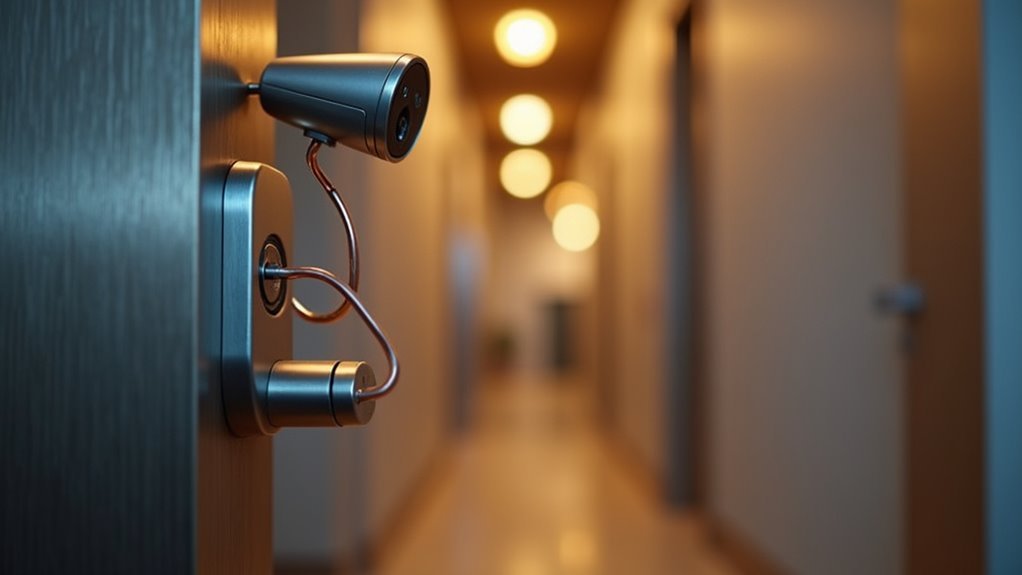You’re probably watching your energy bills climb month after month, wondering what you can do to regain control. Smart home technology isn’t just about convenience anymore—it’s become your most powerful weapon against wasteful energy consumption. The right combination of automated systems can slash your utility costs while making your home more comfortable than ever. But here’s what most homeowners don’t realize about maximizing these savings.
Smart Thermostats for Automated Climate Control

When you’re looking to reduce your home’s energy consumption without sacrificing comfort, smart thermostats offer one of the most effective solutions available.
These intelligent devices use machine learning to adapt to your daily schedule and preferences, automatically optimizing temperature settings for maximum energy efficiency. Popular models like the Nest Learning Thermostat and Ecobee SmartThermostat feature geofencing technology that adjusts temperatures based on your location, preventing energy waste when you’re away.
You’ll appreciate the detailed energy usage reports that help you track consumption patterns and make informed decisions about your heating and cooling habits.
When integrated with occupancy sensors and other smart home devices, these thermostats can deliver energy savings of up to 15% on your utility bills.
Energy Monitoring Systems for Real-Time Usage Tracking
While smart thermostats provide excellent automated control over your HVAC system, energy monitoring systems take efficiency to the next level by giving you complete visibility into your home’s power consumption.
Devices like Sense Energy Monitor and Emporia Vue offer real-time tracking of every appliance’s energy usage, helping you identify the biggest power drains in your home.
You’ll receive instant alerts when devices consume unusual amounts of energy, catching issues like malfunctioning appliances or forgotten lights before they impact your bills.
These systems provide detailed analytics that reveal your consumption patterns over time, enabling smarter energy decisions.
Integration with smart home devices allows automated responses based on real-time data.
Research shows households using energy monitoring systems can reduce energy consumption by up to 20%.
Smart Lighting Solutions for Optimized Power Consumption

How can switching to smart lighting transform your energy consumption while maintaining perfect ambiance throughout your home?
Smart lighting solutions like Philips Hue and LIFX deliver remarkable energy savings of up to 75% compared to traditional incandescent bulbs. You’ll save energy through automated scheduling, remote controls, and motion sensors that eliminate unnecessary usage when rooms are unoccupied.
Smart lighting systems slash energy consumption by three-quarters while giving you complete control over when and where lights operate.
These energy efficient systems offer three key advantages:
- Dimming capabilities reduce energy consumption by an additional 40% while creating perfect lighting moods.
- Motion sensors automatically shut off lights in empty rooms, preventing wasted electricity.
- Home automation integration creates customized scenarios based on occupancy and time patterns.
Studies show smart lighting can reduce your overall electricity bills by 10-20%, making it an intelligent investment for energy efficient homes.
Smart Power Strips to Eliminate Vampire Energy Draw
Beyond optimizing your lighting system, smart power strips offer another powerful strategy to slash your energy bills by targeting vampire energy draw. These devices tackle the 5% to 10% of total home energy consumption caused by standby power waste from electronics that continue drawing electricity even when turned off.
Smart power strips automatically cut power to unused devices, eliminating energy waste from high-consumption appliances like TVs and audio systems. The TP-Link HS300 exemplifies this technology, managing six individual appliances with energy tracking and scheduling capabilities.
| Feature | Benefit |
|---|---|
| Automatic Power Cutoff | Eliminates vampire energy |
| Individual Device Tracking | Monitors energy consumption |
| Remote Control | Convenient appliance management |
| Scheduling Functions | Optimizes energy savings |
| Multi-Device Management | Controls multiple appliances |
You’ll achieve significant energy savings while enhancing your smart home’s overall efficiency.
Smart Appliances for Enhanced Energy Performance

When you upgrade to smart appliances, you’re investing in technology that automatically optimizes energy performance through advanced sensors and intelligent algorithms.
These appliances dramatically reduce energy consumption by scheduling operations during off-peak hours and learning your usage patterns.
Look for ENERGY STAR certification when selecting smart appliances to guarantee maximum efficiency.
Your smart dishwasher senses load size and soil levels, while moisture-sensing dryers prevent over-drying by adjusting cycles automatically.
- The Samsung Family Hub Refrigerator gleaming in your kitchen, its intelligent display showing energy savings while optimizing cooling patterns
- Your LG Smart ThinQ washer quietly humming as it calculates the perfect water temperature and cycle length
- Remote monitoring dashboards illuminating your phone screen with real-time consumption data and efficiency recommendations
Frequently Asked Questions
How to Set up a Smart Home for Energy Efficiency?
You’ll create a compatibility plan, install smart thermostats with occupancy sensors, use smart power strips, monitor energy reports regularly, and update device firmware consistently to maximize your home’s energy efficiency.
What Are Energy-Efficient Smart Devices?
You’ll find energy-efficient smart devices include thermostats that learn your preferences, LED lighting systems, smart power strips preventing phantom loads, energy monitors providing real-time insights, and ENERGY STAR certified appliances with scheduling features.
How Can a Smart Home Help to Save Energy?
You’ll save energy through automated scheduling that optimizes heating and cooling, smart lighting that adjusts automatically, power strips that eliminate standby waste, and real-time monitoring that identifies energy-hungry devices.
What Is the Most Energy-Efficient Home to Build?
You’ll build the most energy-efficient home by combining high-performance insulation, energy-efficient windows, airtight construction, solar panels, Energy Star appliances, and smart thermostats for maximum energy savings.





Leave a Reply